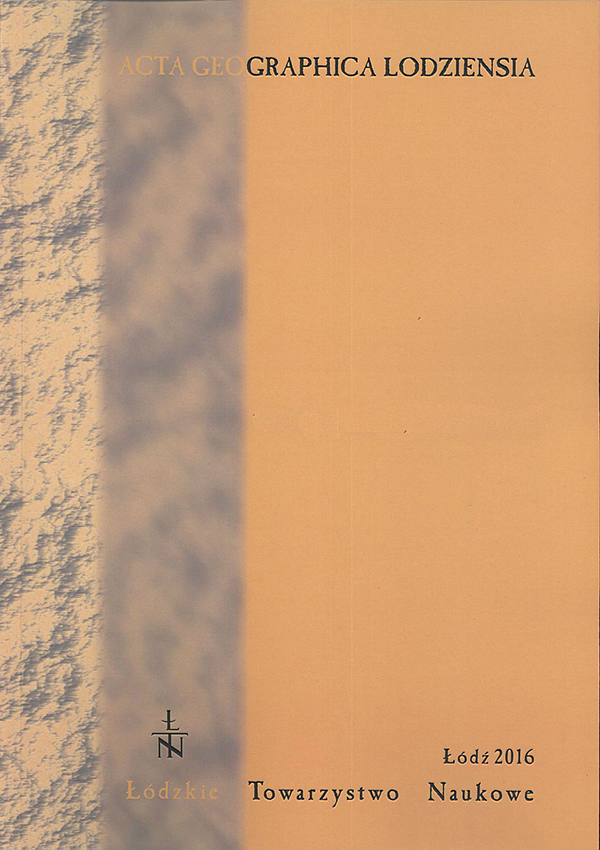Zapis holoceńskich procesów eolicznych w osadach wybranych jezior kopalnych i torfowisk centralnej Polski
Record of Holocene aeolian processes in deposits of selected palaeolakes and peatlands in Central Poland
Author(s): Juliusz Twardy, Jacek ForysiakSubject(s): Geography, Regional studies, Environmental Geography
Published by: Łódzkie Towarzystwo Naukowe
Keywords: peatlands; dunes; aeolian sand covers; Holocene; human impact; Central Poland
Summary/Abstract: Problems concerned with the relationship between aeolian processes and landforms and the functioning of lake-peatland areas have been often highlighted in the scientific literature. The present articleis focused on the spatial relationship between aeolian landforms and wetlands as well as on theinteraction between dunes and wetlands during their evolution in the Holocene. Assuming that theconditions of aeolian processes in Central Poland were in that period inducted by human activity, afew sites were presented, where aeolian processes influenced the formation of the marginal parts ofpeatbogs adjacent to dunes. That caused a clear record of aeolian processes in biogenic sediments. At afew sites in the vicinity of Łódź, there are accumulation basins of biogenic material developing generallyfrom the Late Vistulian as lake basins and in the Holocene the sedimentation continued or transformedinto peatlands. To the peatbogs aeolian forms, mainly dunes, adhere and in the contact zonebiogenic sediments interlock with aeolian deposits. Such situation has been documented at the Witówsite, which like the next described study site Podgórze, is located in the Warsaw-Berlin ice-marginal valley. The Czarny Las site is situated in the longitudinal section of the Warta River valley, and theRąbień site is located in the Łask Plain within an area of morainic plateau and a first order watershed.In the profiles of sandy and organic sediments investigated by several methods, including pollen analysis,lithological studies, radiocarbon dating as well as archaeological survey, the horizons documentingalmost all phases of the settlement recognized for Central Poland. Human activity and initiation of dune destruction occurred in the Mesolithic and were determined by expansion of the Komornica culture (Witów, Rąbień), which resulted in deposition of sand on the lee sides of the dunes and their development toward the adjacent wetlands. At the Rąbień site, also distinct record of aeolian activitycorrelated the Janisławice culture from the Mesolithic has been detected. Neolithic aeolian episodeshave been documentted at Rąbień where the marginal part of the peatland was covered by series ofsand, but no archaeological relicts from this period were documented at the site and its surroundings. Symptoms of the Neolithic activity marked also at the Witów and Czarny Las sites. Human activityfrom the Bronze Age was registered in the deposits of the dune and the peatland at the Rąbień site. The Iron Age is recorded in the deposits at the foot of the dune at Czarny Las, also as covering by sandpart of the peatland at Rąbień and as encroachment of the dune on the small peatland at Podgórze.Throughout the Holocene, a record of aeolian processes development near peatbogs was marked.In the Mesolithic the record of aeolian processes in the marginal parts of peat deposits consisted inaccumulation of thin sandy layers and inserts of dune sands. For the Neolithic and Bronze Age, anincrease in the thickness of layers of aeolian provenance is recorded, which is an expression of theresumption of migration of inland dunes yet on a small scale. The contact zone between dunes andpeatlands with interlocking aeolian processes and paludification processes expanded. In the Iron Agethe marginal parts of some peatbogs (eg. Rąbień) or small peatland near dunes (site Podgórze) underwent covering by aeolian material. Throughout the Mesolithic, preference to settle dunes surroundinglakes, wetlands and peatland remained. Environments characterized by very high contrast were inhabitedand exploited. Human groups directly settled in the area of dry aeolian geosystem while nearbywere lake and peatland geosystems. The pressure exerted by the man on the sensitive components ofthe natural environment resulted in the record of several thousand years of interference of aeolian processesin lake-peatland geosystem.
Journal: Acta Geographica Lodziensia
- Issue Year: 2016
- Issue No: 105
- Page Range: 125-140
- Page Count: 16
- Language: Polish

